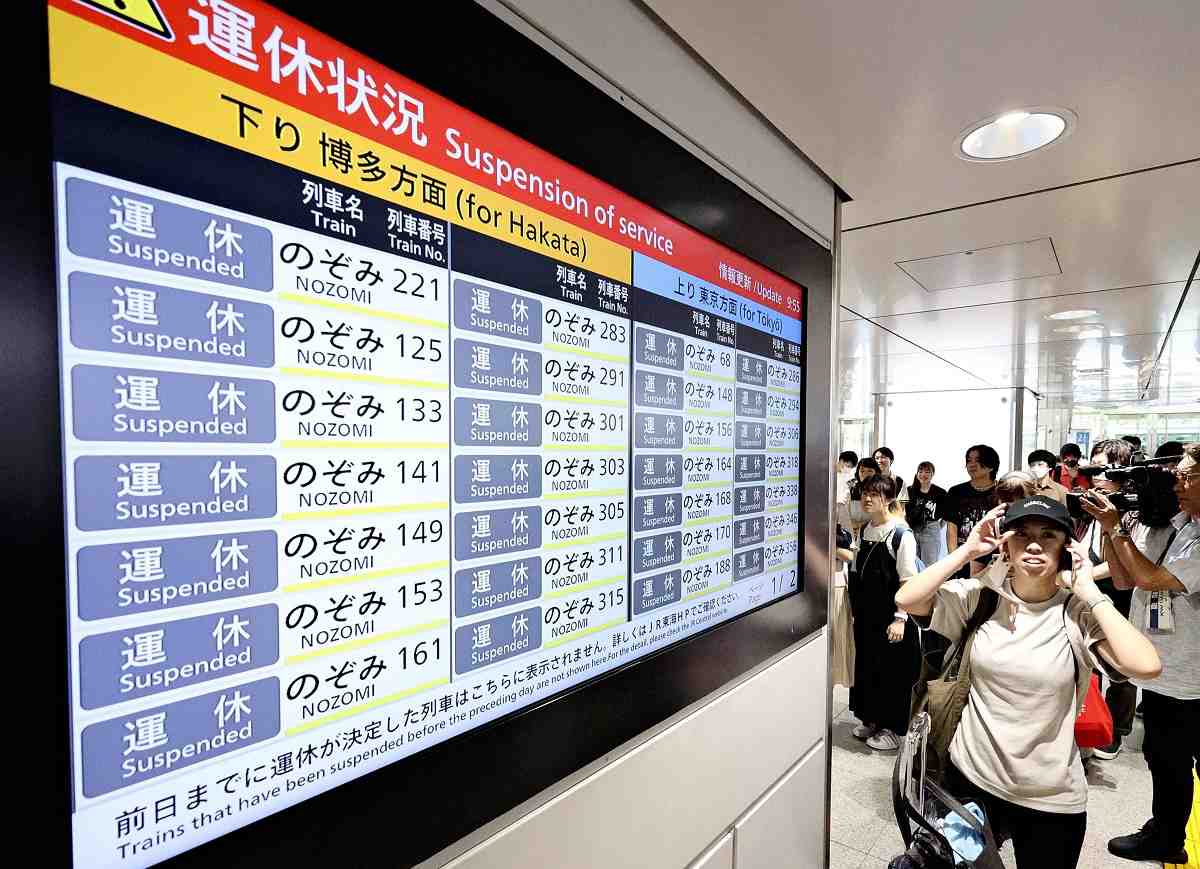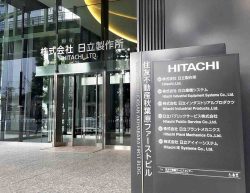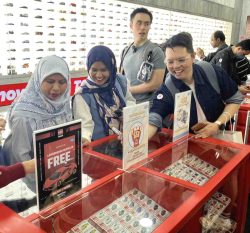JR Tokai Preparing Shinkansen Service for Heavy Rains; Utilizing New System for Announcements

To accommodate two Shinkansen trains at a single platform, one stops about 50 meters ahead of the other in a drill at JR Shinagawa Station on May 22.
11:54 JST, June 19, 2024
Last summer, heavy rainfall caused multiple disruptions to the Tokaido Shinkansen timetable, leaving passengers stranded on board trains and causing confusion.
Reflecting on the incidents, Central Japan Railway Co. (JR Tokai) has reviewed the method for releasing information on its operation during heavy rains and is also taking measures in regard to railroad structures, such as railway embankment. Officials are urging users to check the latest operation information when heavy rain is forecasted.
2 trains on one platform
At around 12:20 a.m. on May 22, a Tokaido Shinkansen train slowly came to a stop at platform No. 24 in JR Shinagawa Station after the departure of the last train. About 50 meters ahead on the same platform was another Shinkansen that had entered earlier.
A drill was conducted on that day with the idea that train operations had been suspended due to heavy rain over an extended period. The train stopped ahead of Shinagawa Station and was moved into the station for passengers to disembark. Two trains were accommodated at a platform where only one would normally stop, and officials checked the timing for opening the exit gates.
“We would like to apply what we learned from the training to our manuals and education, such as the procedure to have passengers disembark through the exit gates even when the positioning of the gates and the train doors are not aligned,” said Masafumi Kondo, head of the transportation sales department of JR Tokai’s Shinkansen Operations Division.
In June 2023, the Tokaido Shinkansen was temporarily suspended due to heavy rains caused by the seasonal rain front. Tokyo Station was packed with stranded passengers, and dozens of junior high school students there on a school trip said that they felt unwell.
In August, the day after a planned service suspension as a precaution ahead of an approaching typhoon, rain gauges in Shizuoka Prefecture showed figures beyond the regulatory limit. This caused some sections of the line to be suspended. Subsequently, Shinkansen service suspensions were extended to the section between Tokyo and Hakata, forcing some trains to stop between stations for an extended period. On Aug. 16 and 17, more than 200 trains were canceled and more than 400 trains were delayed on the Tokaido Shinkansen line alone, affecting about 500,000 passengers.
Timetable app improvements

Information on the cancellations of Shinkansen trains is displayed on a notice board at JR Tokyo Station on Aug. 17, 2023.
One of the lessons JR Tokai learned from these experiences last summer was the need to provide faster and more accurate information.
In the past, when there was a possibility of service delays or cancellations due to heavy rain or other factors, the company notified passengers after an alternative service plan was prepared. But it changed operational procedures to announce the possibility of service suspensions or other problems at an earlier stage, before the service plan is decided. On May 28 of this year, when the appearance of heavy rain clouds was a suspected, the company quickly announced the possibility of delays or cancellations.
The company additionally began increasing the frequency of announcements on social media and other media after suspending operations, even if the situation was unchanged. It also upgraded the Shinkansen timetable app at the end of last year. Previously, it had mainly used a website on Shinkansen operation information as its main tool to disseminate information. The Shinkansen timetable made it possible for users to check operational status in real time.
Installing sensors at 18 locations
The company also began taking measures to protect railway embankments from rainfall.
According to JR Tokai, 44% of all Tokaido Shinkansen lines run on an embankment. This percentage is the highest among all Shinkansen lines in the country. If rainwater seeps into the embankment, the soil will loosen and increase the risk of collapse. It may cause rail distortions and result in the derailment of trains in the worst case. In order to prevent rainwater from seeping into embankments, the railway company has been taking preventive measures, such as covering the surface of the embankment with concrete and installing pipes to drain water.
In June, the company began constant monitoring of water in the soil during rainfall to gain a detailed understanding of its distribution. Sensors that monitor the distribution of water have been installed in embankments at 18 locations in Shizuoka Prefecture, including Shizuoka City. It also created holes in the ground to observe the rise of groundwater levels at two locations nearby. The company plans to compile the results after monitoring the data for about two years. After evaluating the performance of embankments at individual locations, it will carry out construction and take appropriate countermeasures.
“We want to improve the safety of our service by creating suitable operational regulations in the event of heavy rains,” said JR Tokai President Shunsuke Niwa said.
"Business" POPULAR ARTICLE
-

Keidanren Chairman Yoshinobu Tsutsui Visits Kashiwazaki-Kariwa Nuclear Power Plant; Inspects New Emergency Safety System
-

Imports of Rare Earths from China Facing Delays, May Be Caused by Deterioration of Japan-China Relations
-

University of Tokyo Professor Discusses Japanese Economic Security in Interview Ahead of Forum
-

Japan Pulls out of Vietnam Nuclear Project, Complicating Hanoi’s Power Plans
-

Govt Aims to Expand NISA Program Lineup, Abolish Age Restriction
JN ACCESS RANKING
-

Keidanren Chairman Yoshinobu Tsutsui Visits Kashiwazaki-Kariwa Nuclear Power Plant; Inspects New Emergency Safety System
-

Imports of Rare Earths from China Facing Delays, May Be Caused by Deterioration of Japan-China Relations
-

University of Tokyo Professor Discusses Japanese Economic Security in Interview Ahead of Forum
-

Japan Pulls out of Vietnam Nuclear Project, Complicating Hanoi’s Power Plans
-

Govt Aims to Expand NISA Program Lineup, Abolish Age Restriction

























